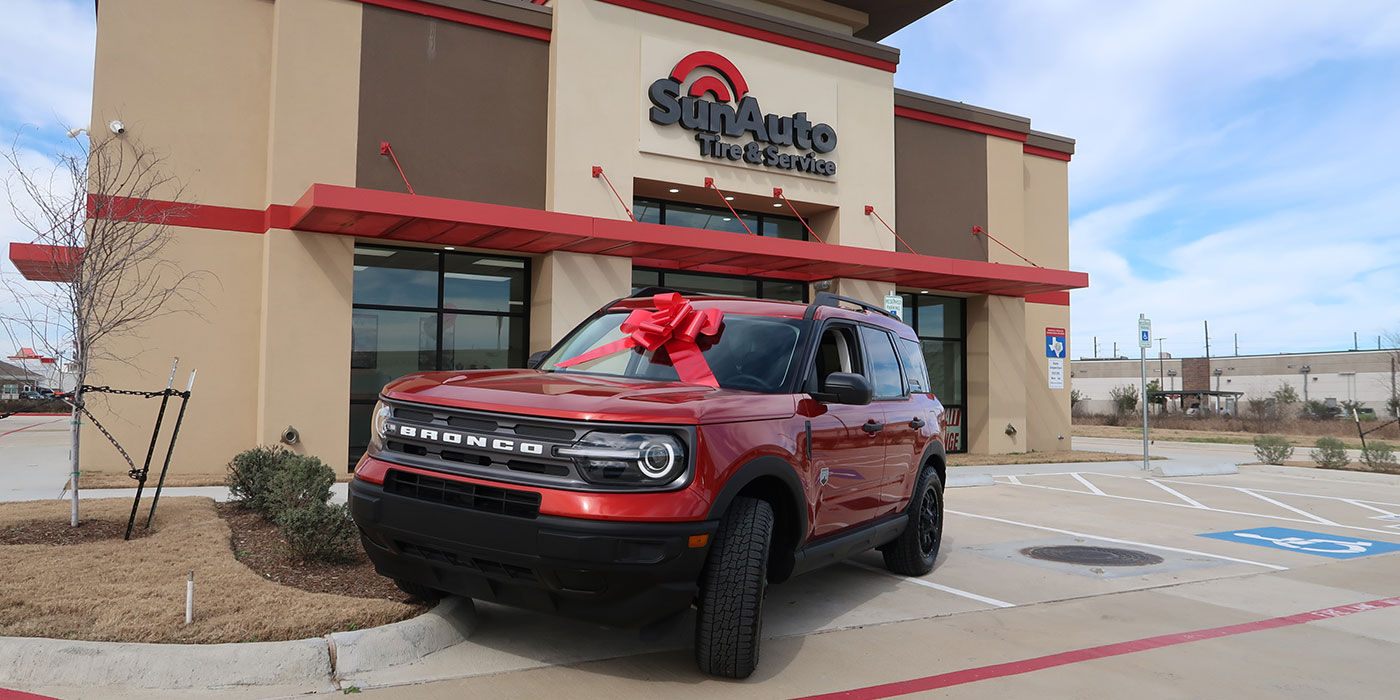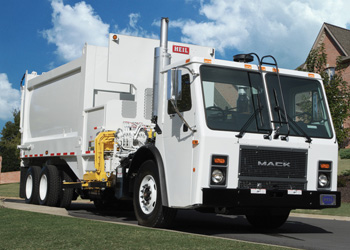 As a technician, mechanic or fleet manager in the heavy-duty market, you will be responsible for servicing and repairing trucks.
As a technician, mechanic or fleet manager in the heavy-duty market, you will be responsible for servicing and repairing trucks.
Because safety on the roads and preservation of the load are imperative to the profitability of a fleet company, much of the service work involves making sure trailers are in good working order.
Here are some service checklist tips from truck and trailer OEs that will come in handy as you head into the H-D service market.
Keeping Your Body in Shape
The following is a basic checklist of items that need to be scheduled for maintenance and repair of trailer dry vans and bodies developed by a national trailer manufacture:
1. Floors and cross members: Minor scrapes and gouges in the floor are not a concern, however if gouges 1/2-in. or more are noted, fill them with crack filler or a floor restorer kit. Floorboards can be sectioned as long as the section covers a minimum of three cross members the full width of the board. Metal plating is not acceptable. Cross members can be straightened as long as the flange is not pulled away from the floor. Cross members that are pulled away from the floor, cut, torn or deflected (bowed downward) more than 1/4-in. must be replaced. When replacing cross members, end clips must be welded and Mylar tape must be used between any dissimilar metals.
2. Roofs and roof bows: Roof patches are acceptable as long as the patches are no more than 3-ft. square and are buck riveted with soft buck rivets. If the hole will require a patch larger than 3-ft. square or there will be more than two patches in a 6-ft. length of roof, the roof must be sectioned. A section must start from the front or rear on the trailer, be less than 50% of the length of the trailer, and only one section per trailer. If these conditions cannot be met, the roof must be replaced. Only buck rivets will be accepted; no pull rivets of any kind.
3. Body panels and posts: Holes in side panels must be repaired by sectioning the complete width of the panel and buck riveting with hard buck rivets. A section must start from the top or bottom of the panel, be less than 50% of the panel, and only one section per panel. If these conditions cannot be met, the panel must be replaced. Caulking or sealant should be put between the panel pieces prior to assembly, not bordering around the section after assembly. Only buck rivets will be accepted; no pull rivets of any kind. Posts must be straightened to their original shape and be free of cuts, otherwise they must be replaced.
4. Rails: Rail sections are acceptable as long as the section starts from the front or rear of the trailer. Only one section per rail is allowed; sections on opposing rails or two rails on the same side are not allowed. If two rails are sectioned, the section must be staggered at least 6 ft. All sections must be reinforced. Bottom rail reinforcements must be at least 4-in. x 1/8-in. flat stock iron extending three cross members on each side of the splice. Top rail reinforcements must be at least 3-in. x 3/16-in. flat stock aluminum extending 18-in. on each side of the splice. Dents and bends in rails should be straightened. If the rail has been bent 1/2-in. or more in either direction, it must also be reinforced. Reinforcements must be at least 4-in. x 1/8-in. flat stock iron extending two cross members beyond each side of the damaged area. Mylar tape must be used between any dissimilar metals. Body panel, post and rail damage on trailers less than one year old may be required to be returned to like-new condition.
5. Doors: Door molding must be repaired if it is cut, broken, if the door core is exposed, or if the door does not fully seal. Door molding can be sectioned as long as the door core is watertight and the splice fully seals when the door is closed. Minor cuts less than 2-in. in the door skin can be sealed with white Silaprene. Any damage where the door core is broken or is no longer watertight necessitates door replacement.
6. Plywood and scuff: Plywood lining with holes or cuts larger than 3-in. or that expose a post must be replaced. The full sheet must be replaced with AC grade plywood. Small cuts and holes smaller than 3-in. where the post is not exposed can be filled with fiberglass reinforced Bondo. No other patching material like foam, regular Bondo, tapes or wood filler will be accepted. If any plywood has been filled with an unacceptable patching material, the full sheet must be replaced, not refilled. Scuff must be full attached with no sharp edges. Broken oak scuff must be replaced. Scuff may be sectioned with the same type scuff as long as steel splices are welded and oak splices are butt jointed on a post.
7. Landing support gear: Bent or damaged legs need to be replaced with the same type of leg. Minor bends in braces can be straightened; however, braces that have a kink must be replaced. Wing and support plates must be welded to the cross members.
8. Undercarriage and mud flaps: All suspension areas must be straightened or replaced as necessary to be in good working order. Axles must be replaced if they are bent or have spindle damage or grooves. No spindles are to be replaced.Worn bushings must be replaced. Bent mud flap brackets must be straightened or replaced. Mud flaps with tears, cuts, holes or cracks must be replaced with DOT approved flaps.
9. ICC bumpers and rear underride guards: Minor bends may be straightened. Any other damaged pieces must be replaced. All replacement parts should be primed and painted to match. (On 1998 and newer trailers, all repairs and replacements must meet federal criteria including a decal showing such.)
10. Lights: The same quality lights and reflectors must be present and in good working order.
11. Decal removal: When removing decals, all damage resulting from their removal should be repaired.
12. Tires: Replacement tires should be of the same quality, design and tread depth to the tires at the initial outbound inspection. If a first line tire is replaced with a retreaded tire, a fee to recover the casing value may apply. Tires should be replaced between 2/32-in. and 4/32-in. of tread remaining. If tires are run below 2/32-in. of tread remaining, a fee to recover any damage to the casing may apply.
13. Brakes: Replacement brakes should be of the same quality material and design to the brakes at the initial outbound inspection. Brakes should be replaced when there is between 25% and 30% (measurements of 14/32-in. to 15/32-in.) of brake lining remaining. If brakes are run below 25% pad remaining, damage from exposed brake shoe rivets may occur, and a fee to recover damage to the brake drum may apply. Notify your local National Semi-Trailer Corp. branch office when brakes are approaching 30% (measurement of 14/32-in. to 15/32-in.) of brake lining remaining to schedule a brake job.
Handling Corrosion
Figuring out how to protect and repair equipment that is subject to corrosion is a challenge. Exposure to the elements, in combination with the complex array of materials handled every day, make corrosion a constant concern for fleet managers, especially those working with refuse collection vehicles (RCVs). One of the best and most proactive ways to help minimize the effects of corrosion on any vehicle is an entrenched, regular cleaning schedule.
This is especially true for RCVs. Cleaning the vehicle not only reduces the effects of any corrosive material that may have become attached to the vehicle body, but it also allows for easy identification and early treatment of any spots where corrosion may become an issue.
Engineers in the H-D industry say there are new trends and developments for combating corrosion issues, including:
• Stainless steel trailers and galvanized components to combat corrosion;
• Interior liners and scuffs that are less susceptible to damage due to their higher puncture-resistance;
• Long-life return-ground, sealed lighting systems;
• Pre-set wheel ends offer low or no maintenance for extended periods;
• Tire inflation systems; and
• Single tires and wheels.
Rear frames and doors pose the biggest problem area for corrosion on trailers. Most doors on dry-freight trailers are plymetal construction with plywood cores and metal skins. The wood acts like an ink blotter and absorbs moisture through any leak, even the smallest hole.
The skin is also part of the problem because it is a chilling agent, and as the temperature cools, a vacuum is created, and the door draws in moisture, which travels throughout the core. This process also is impacted by gravity, which is why fleet manager see the worst galvanic corrosion at the bottom of the door.
To prevent this occurrence, some OEs have begun to eliminate plywood from rear doors, using a material that does not absorb moisture and has the added benefit of allowing door seals to be screwed in place. By contrast, fasteners on wood core doors can act as moisture conduits and are often destroyed by corrosion from the inside.
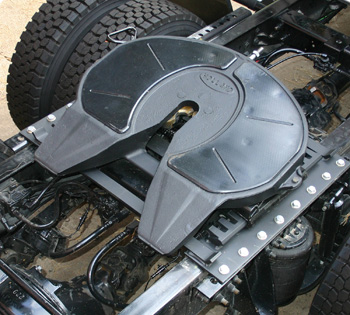 Making the Right Connection
Making the Right Connection
The proper connection between trailer and tractor starts with proper maintenance of the fifth wheel. Routine, periodic maintenance and lubrication are a necessary part of fifth wheel service life.
To get the maximum performance, follow the steps below at the intervals shown:
• Thoroughly clean the locking mechanism every 6 months or 60,000 miles; • Inspect for bent, broken or missing parts every 6 months or 60,000 miles. Replace as necessary;
• Re-lube and inspect regularly; and • Check the operation by locking and unlocking using a lock tester. Verify that the fifth wheel is completely closed.
Note: Basic maintenance is the key to good performance. Always follow the manufacturer’s recommended procedures for the best success.
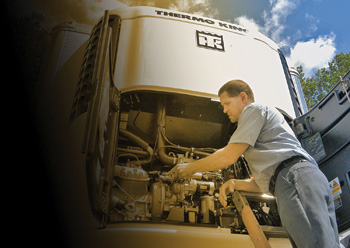 Chilled Out — Reefer Unit Maintenance
Chilled Out — Reefer Unit Maintenance
Here’s a short list of items to check on refrigerated units and trailers.
Unit Examination:
• Place all unit switches in the “Off” position;
• Check unit doors – open, close and latch properly;
• Check defrost drain hoses and flapper valves;
• Check for coolant leaks;
• Check for oil and fuel leaks;
• Reset/Check engine air restriction indicator;
• Check for loose, frayed, or chaffed wiring;
• Visual check of drive belts;
• Check reset switch circuit in Continuous Run;
• Check coolant level;
• Check battery cable connections;
• Check battery hold-downs; and
• Check for proper engine oil level.
Inside trailer:
• Check front bulkhead, floor channels and air chute for air flow restrictions.
Multi-temp units only –– check:
• Remote evaporators for damage;
• For damaged, loose/missing hardware;
• Defrost drain hoses and flapper valves; and
• Compartment bulk head(s).
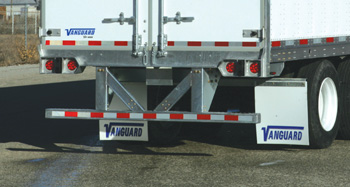 Bringing Up the Rear
Bringing Up the Rear
Don’t forget to check the rear impact guards. Make their inspection routine. FMVSS 223 and 224 regulate the strength, location and energy absorption and dimensions of rear impact guards.
Certification labels or plates are required to be visible on the forward facing surface of the horizontal member and located within 12 in. of the outside of the horizontal member on the curbside of the unit.
If fleet equipment is outfitted with liftgates, regularly schedule inspection and maintenance. Make sure drivers report problems promptly. Do visual inspections to check for oil leaks, uneven ramps or platforms, missing parts, compromised weld or cracking.
Always check the mechanical operation to make sure the liftgate is functioning properly during raising and lowering. Check the pump/motor and wiring and/or switches. Make sure all safety devices are working properly.



